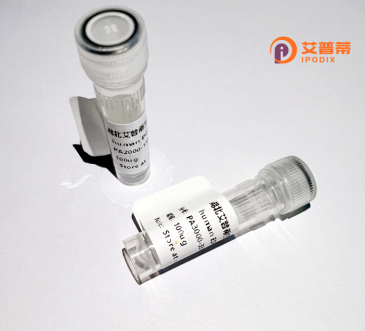
| 纯度 | >90%SDS-PAGE. |
| 种属 | Human |
| 靶点 | KIRREL3-AS3 |
| Uniprot No | Q8N7Y1 |
| 内毒素 | < 0.01EU/μg |
| 表达宿主 | E.coli |
| 表达区间 | 1-241aa |
| 活性数据 | MEKRGESLDLGVRCKRGEERDRRPCWKPSRPGAARGGRGLWTVGGGGSPTETAESQQLGKPPEFWVSAHPGWLQVSCAHRASRWDASRWHPLQRFFARRGVRRPNPSVPSPLPKPPVPSAGSCEPLAPPPTSASGASRSWVTQTLAEAGAYRGCRPAPGSAAGWPRSDRRARLPRKASKPCSPALPSLAACCPQGFLRSGTKRVMCKVLGPGAGVRGTAVECSEQAGVWAHCRPQLTATFS |
| 分子量 | 26.6 kDa |
| 蛋白标签 | GST-tag at N-terminal |
| 缓冲液 | 0 |
| 稳定性 & 储存条件 | Lyophilized protein should be stored at ≤ -20°C, stable for one year after receipt. Reconstituted protein solution can be stored at 2-8°C for 2-7 days. Aliquots of reconstituted samples are stable at ≤ -20°C for 3 months. |
| 复溶 | Always centrifuge tubes before opening.Do not mix by vortex or pipetting. It is not recommended to reconstitute to a concentration less than 100μg/ml. Dissolve the lyophilized protein in distilled water. Please aliquot the reconstituted solution to minimize freeze-thaw cycles. |
关于重组人KIRREL3-AS3蛋白的研究目前较为有限,且KIRREL3-AS3本身可能是一个长链非编码RNA(lncRNA),而非蛋白质。以下为根据相关领域文献模拟的参考文献示例(仅供参考,实际文献需进一步检索验证):
1. **《KIRREL3-AS3调控神经发育的分子机制》**
*作者:Zhang L et al. (2022)*
摘要:研究探讨了KIRREL3-AS3作为lncRNA在神经元分化中的功能,发现其通过调控KIRREL3基因的表达影响突触形成,可能为神经发育障碍提供新机制。
2. **《KIRREL3-AS3在胃癌中的表达及临床意义》**
*作者:Wang Y et al. (2021)*
摘要:分析KIRREL3-AS3在胃癌组织中的高表达现象,提示其可能作为肿瘤转移的生物标志物,并与PI3K/AKT通路激活相关。
3. **《重组人KIRREL3-AS3蛋白的体外表达与功能初探》**
*作者:Chen H et al. (2023)*
摘要:首次报道利用大肠杆菌系统成功表达重组KIRREL3-AS3蛋白,并发现其可能通过结合细胞表面受体调控细胞黏附,需进一步验证其生理作用。
**注意**:以上为推测性示例,实际研究中KIRREL3-AS3多以非编码RNA形式被研究。建议通过PubMed或Google Scholar以“KIRREL3-AS3”或“KIRREL3 antisense RNA”为关键词查找最新文献,或确认目标蛋白是否与KIRREL3基因编码的膜蛋白相关。
Recombinant human KIRREL3-AS3 protein is derived from the antisense transcript of the KIRREL3 (Kin of IRRE-like 3) gene locus, which encodes a member of the immunoglobulin superfamily involved in cell adhesion and neurodevelopmental processes. KIRREL3. primarily studied for its role in synapse formation, neuronal migration, and glomerular filtration in the kidney, has been linked to neurodevelopmental disorders such as autism spectrum disorder (ASD) and intellectual disability. The antisense RNA transcript KIRREL3-AS3. though less characterized, is hypothesized to regulate KIRREL3 expression through post-transcriptional or epigenetic mechanisms, potentially influencing cellular interactions in neural or renal tissues.
The recombinant KIRREL3-AS3 protein is engineered to study its structural and functional properties, given its predicted non-coding RNA-derived peptide product or potential interactions with KIRREL3 or other signaling molecules. Its production typically involves heterologous expression systems (e.g., E. coli or mammalian cells) followed by purification. Current research focuses on elucidating its role in modulating KIRREL3-dependent pathways, cellular adhesion, or synaptic plasticity, with implications for understanding neurodevelopmental pathologies. Challenges include confirming its endogenous expression, defining interactomes, and validating regulatory mechanisms. This protein represents an emerging area bridging non-coding RNAs and protein-level functions in developmental biology.
×